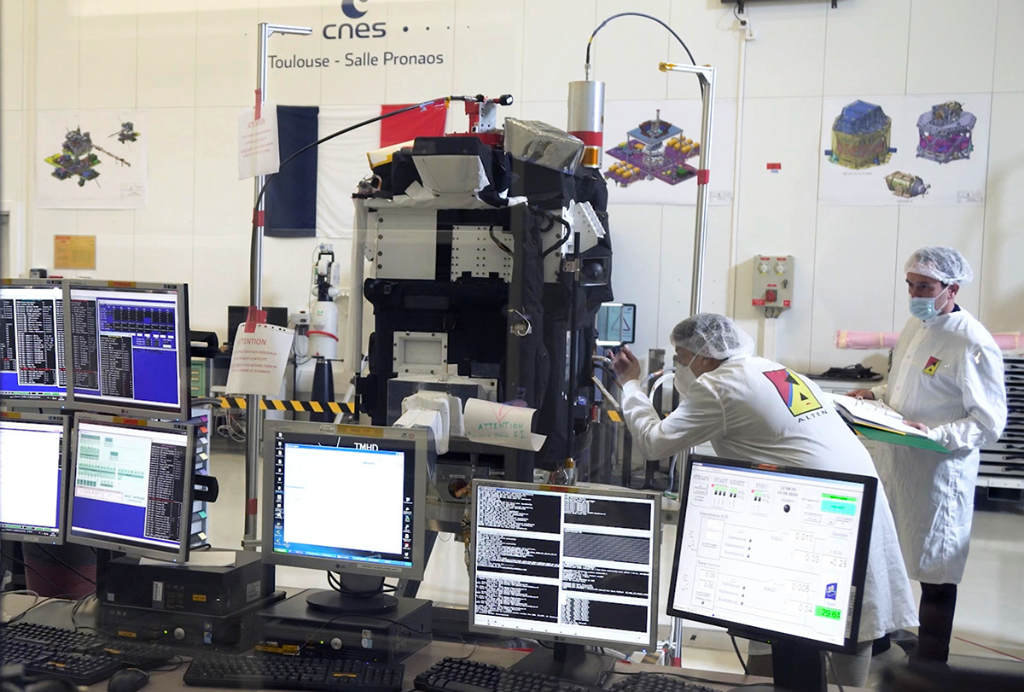The TARANIS satellite is the result of a collaboration between the Centre National d’Etudes Spatiales (CNES [French National Centre for Space Studies]) and its partners, ALTEN included. Our teams were specifically responsible for the Assembly, Integration and Testing of this technological masterpiece. A review of what has been an extraordinary adventure, as seen from the inside by our teams, who still have stars in their eyes!
What is the purpose of this satellite?
The observation of electromagnetic events in the upper layers of the atmosphere, especially above thunderstorm clouds, is the ambitious mission of TARANIS (the god of storms and lightning in Gallic mythology).
What we see from Earth is lightning and sometimes hailstones. But luminous events occur above the clouds. They were first noticed by airline pilots, who almost thought they were having hallucinations when they observed these blue and red sprites of light! These events actually last a few milliseconds and are caused by luminous and gamma-ray flashes which occur at an altitude of 20 to 100 km.
CNES hopes to explain these phenomena using TARANIS: what causes them and what is their purpose? Can they have an effect on climate, or on the Earth itself?
TARANIS will be equipped with a dozen instruments, including photon and X-ray detectors as well as large high & low frequency antennas, with which to record the simultaneous and high-resolution optical, gamma-ray, electronic and electromagnetic signatures of luminous flashes.
This is a very complex development which has involved ALTEN engineers at CNES in Toulouse, before the satellite went through a whole battery of tests (environmental, performance and even good health!). The satellite, which weighs just 200 Kg on the scale but proudly achieves the required volume passed the tests with flying colours.
ALTEN, the AIT specialist
ALTEN, in conjunction with CNES, has been providing AIT services for more than 15 years for the micro-satellite sector (satellites not exceeding 400 kg).
With the TARANIS mission, ALTEN has once again demonstrated its ability to carry out all the AIT stages. This is a very exacting contract, covering the last part of the satellite’s preparation before its flight operations: piece-by-piece construction, reproduction of the space restrictions and of all the scenarios it may encounter in its sun-synchronous orbit at an altitude of 700 Km, installation on the launcher, etc.
More specifically, the AIT engineering work on the electrical and operational system consists of drafting and rolling out in a cleanroom environment, the test procedures for the flight equipment, requiring control of all the component subsystems:
- Power: onboard energy management module
- Radiofrequency: transmitters, receivers, air-to-ground communication
- Onboard management: flight computer and software
- Temperature control: heaters, thermistors
- Pyrotechnic deployment (for solar generators and antennas)
Of course, all of these tests require technical expertise, especially in electrical-electronics, functional validation, mechanics and radio-frequency among others! ALTEN’s know-how also lies in the teams’ ability to manage a project, ensure its quality, anticipate problems and restructure operations if necessary, etc.
Working on a satellite also means being part of a team with a common goal, in a very special “cleanroom” environment.
This environment is all the more unique when we consider that the TARANIS teams have had to adapt to even more drastic hygiene and cleanliness conditions imposed by the health crisis, in order to meet the scheduling challenges as well as possible.
If AIT means a very exacting work pace, the ALTEN engineers who have worked on the TARANIS AIT since 2014 are nonetheless very proud of it. What is it like to work for CNES, a key player in the space industry, with state-of-the-art instruments and equipment that will advance scientific research?
An outstanding experience and lasting memories, as confirmed by Dominique Palanque, ALTEN Project Director:
“Seeing a rocket power up and soar through the sky carrying a satellite that we have worked on for several years is a moment that will remain etched in our minds for a very long time.”
The TARANIS launch
This is a quite different chapter in the life of TARANIS which began in mid-November in Kourou: this was its great leap into outer space, on a mission of 2 to 4 years. Unfortunately, on November 17, 2020, it was announced that the Vega launcher, which was supposed to put the TARANIS satellite into orbit, had failed. 8 minutes after take-off, and after firing the 4th stage of the launcher, a trajectory degradation was detected, leading to the failure of the mission.
The ALTEN Group wishes to express its full and complete support for all the teams involved for several years on this project, and in particular for the ALTEN teams who worked on the satellite AIT. The design and integration of the TARANIS satellite have led to many advances in terms of space engineering. Although the mission was unsuccessful, its added value remains undeniable on the technological level and the lessons learned on the TARANIS experience will feed into future AIT projects.









